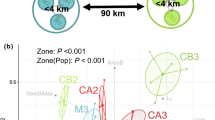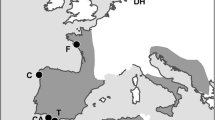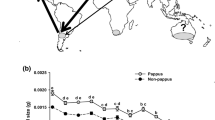Abstract
Intraspecific variation in seed size may result from life-history constraints or environmental conditions experienced. This variation in seed size is likely to affect the early stage of invasion as seed size may contribute to the success or failure of population establishment. However, only a few studies have examined seed size variability and its causes and consequences for invaders so far. Using the invasive herb Lupinus polyphyllus, we estimated seed mass variation within and among 39 populations from two different geographic regions in a part of the invaded range. We empirically and experimentally evaluated the effect of seed number and environmental conditions (e.g. geographic region, habitat type, intraspecific competition) on seed mass, emergence and seedling performance. Seed mass varied threefold, being largest among individual plants within populations and smallest among populations. Variation in seed mass was neither related to seed number nor the environmental conditions examined, but led to differences in offspring performance, with emergence and seedling size increasing with seed mass. Larger L. polyphyllus seeds were better establishers than smaller seeds regardless of environmental conditions, indicating that the success of L. polyphyllus invasions is likely to depend positively on seed mass. Our results suggest that some plant species such as the invasive L. polyphyllus may not show an adaptive response in seed mass to resources or environmental conditions, which may partly explain their ability to colonise a range of different habitats.



Similar content being viewed by others
References
Aniszewski A, Kupari MH, Leinonen AJ (2001) Seed number, seed size and seed diversity in Washington lupin (Lupinus polyphyllus Lindl.). Ann Bot 87:77–82
Baraloto C, Forget P-M, Goldberg DE (2005) Seed mass, seedling size and neotropical tree seedling establishment. J Ecol 93:1156–1166
Bates D, Maechler M, Bolker B (2011) lme4: linear mixed-effects models using S4 classes. R package version 0.999375-41
Bolker BM, Brooks ME, Clark CJ, Geange SW, Poulsen JR, Stevens MHH, White JS (2009) Generalized linear mixed models: a practical guide for ecology and evolution. Trends Ecol Evol 24:127–135
Buckley YM, Downey P, Fowler SW, Hill R, Memmot J, Norambuena H, Pitcairn M, Byers DL, Platenkamp GAJ, Shaw RG, Sheppard AW, Winks C, Wittenberg R, Rees M (2003) Are invasives bigger? A global study of seed size variation in two invasive shrubs. Ecology 84:1434–1440
Buswell J, Moles A, Hartley S (2011) Is rapid evolution common in introduced plant species? J Ecol 99:214–224
Crawley MJ (2009) The R Book, 2nd edn. Wiley, Chichester
Davidson AM, Jennions M, Nicotra AB (2011) Do invasive species show higher phenotypic plasticity than native species and, if so, is it adaptive? A meta-analysis. Ecol Lett 14:419–431
Dlugosch KM, Parker IM (2008) Founding events in species invasions: genetic variation, adaptive evolution, and the role of multiple introductions. Mol Ecol 17:431–449
Eriksson O (1999) Seed size variation and its effect on germination and seedling performance in the clonal herb Convallaria majalis. Acta Oecol 20:61–66
Global Invasive Species Database, http://www.issg.org
Gundel PE, Garibaldi LA, Martínez-Ghersa MA, Ghersa CM (2012) Trade-off between seed number and weight: influence of a grass-endophyte symbiosis. Basic Appl Ecol 13:32–39
Halpern SL (2005) Sources and consequences of seed size variation in Lupinus perennis (Fabaceae): adaptive and non-adaptive hypotheses. Am J Bot 92:205–213
Harper JJ, Lovell P, Moore KG (1970) The shapes and sizes of seeds. Annu Rev Ecol Syst 1:327–356
Ladd D, Cappuccino N (2005) A field study of seed dispersal and seedling performance in the invasive exotic vine Vincetoxicum rossicum. Can J Bot 83:1181–1188
Lambrecht-McDowell SC, Radosevich SR (2005) Population demographics and trade-offs to reproduction of an invasive and non-invasive species of Rubus. Biol Invasions 7:281–295
Lampinen R, Lahti T (2011) Kasviatlas 2010. University of Helsinki, Finnish Museum of Natural History, Botanical Museum, Helsinki. http://www.luomus.fi/kasviatlas
Michaels HJ, Benner B, Hartgerink AP, Lee TD, Rice S, Willson MF, Bertin RI (1988) Seed size variation: magnitude, distribution and ecological correlates. Evol Ecol 2:157–166
Moegenburg SM (1996) Sabal palmetto seed size: causes of variation, choices of predators, and consequences for seedlings. Oecologia 106:539–543
Moles AT, Leishman MR (2008) The seedling as part of a plant’s life history strategy. In: Leck MA, Parker VT, Simpson RL (eds) Seedling ecology and evolution. Cambridge University Press, Cambridge, pp 217–238
Parciak W (2002) Environmental variation in seed number, size, and dispersal of a fleshy-fruited plant. Ecology 83:780–793
Paul-Victor C, Turnbull LA (2009) The effect of growth conditions on the seed size/number trade-off. PLoS ONE 4(9):e6917
Pichancourt J-B, van Klinken RD (2012) Phenotypic plasticity influences the size, shape and dynamics of the geographic distribution of an invasive plant. PLoS ONE 7:e32323
Pinheiro J, Bates B, DebRoy S, Sarkar D, the R Development Core Team (2011) nlme: linear and nonlinear mixed effects models. R package version 3.1-101
R Development Core Team (2012) R: a language and environment for statistical computing. R Foundation for Statistical Computing. Vienna, Austria. ISBN 3-900051-07-0. http://www.R-project.org
Ramula S, Pihlaja K (2012) Plant communities and reproductive success of native plants after the invasion of an ornamental herb. Biol Invasions 14:2079–2090
Richards CL, Bossdorf O, Muth NZ, Gurevitch J, Pigliucci M (2006) Jack of all trades, master of some? On the role of phenotypic plasticity in plant invasions. Ecol Lett 9:981–993
Ridenour WM, Vivanco JM, Feng Y, Horiuchi J, Callaway RM (2008) No evidence for trade-offs: Centaurea plants from America are better competitors and defenders. Ecol Monogr 78:369–386
Sakai AK, Allendorf FW, Holt JS, Lodge DM, Molofsky J, With KA, Baughman S, Cabin RJ, Cohen JE, Ellstrand NC, McCauley DE, O’Neil P, Parker IM, Thompson JN, Weller SG (2001) The population biology of invasive species. Annu Rev Ecol Syst 32:305–332
Schaal BA (1980) Reproductive capacity and seed size in Lupinus texensis. Am J Bot 67:703–709
Simons AM, Johnston MO (2000) Variation in seed traits of Lobelia inflata (Campanulaceae); sources and fitness consequences. Am J Bot 87:124–132
Smith CC, Fretwell SD (1974) The optimal balance between size and number of offspring. Am Nat 108:499–506
Susko DJ, Cavers PB (2008) Seed size effects and competitive ability in Thlaspi arvense L. (Brassicaceae). Botany 86:259–267
Susko DJ, Lovett-Doust L (2000) Patterns of seed mass variation and their effects on seedling traits in Alliaria petiolata (Brassicaceae). Am J Bot 87:56–66
Tang C, Robson AD (1993) pH above 6.0 reduces nodulation in Lupinus species. Plant Soil 152:269–276
Tautenhahn S, Heilmeier H, Götzenberger L, Klotz S, Wirth C, Kühn I (2008) On the biogeography of seed mass in Germany—distribution patterns and environmental correlates. Ecography 31:457–468
Timmins SM, Mackenzie IW (1995) Weeds in New Zealand protected natural areas database. Department of Conservation Technical Series No 8. Department of Conservation, Wellington, New Zealand
van Kleunen M, Fischer M, Schmid B (2001) Effects of intraspecific competition on size variation and reproductive allocation in a clonal plant. Oikos 94:515–524
van Kleunen M, Weber E, Fischer M (2010) A meta-analyses of trait differences between invasive and non-invasive plant species. Ecol Lett 13:235–245
Vaughton G, Ramsey M (1998) Sources and consequences of seed mass variation in Banksia marginata (Proteaceae). J Ecol 86:563–573
Venable DL (1992) Size-number trade-offs and the variation of seed size with plant resource status. Am Nat 140:287–304
Willis SG, Hulme PE (2004) Environmental severity and variation in the reproductive traits of Impatiens glandulifera. Funct Ecol 18:887–898
Wulff RD (1986) Seed size variation in Desmodium paniculatum. II Effects on seedling growth and physiological performance. J Ecol 74:99–114
Acknowledgments
We thank Tuija Häkkilä and Kati Pihlaja for assistance with seeds, Jodi Price and two anonymous reviewers for their helpful comments, and the Emil Aaltonen Foundation and the Academy of Finland for funding.
Author information
Authors and Affiliations
Corresponding author
Rights and permissions
About this article
Cite this article
Sõber, V., Ramula, S. Seed number and environmental conditions do not explain seed size variability for the invasive herb Lupinus polyphyllus . Plant Ecol 214, 883–892 (2013). https://doi.org/10.1007/s11258-013-0216-8
Received:
Accepted:
Published:
Issue Date:
DOI: https://doi.org/10.1007/s11258-013-0216-8




